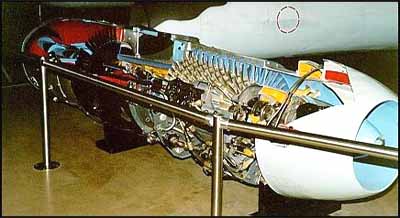This is a print of an original negative; My guess it's a me226 engine? and we're looking at the rear of that engine? What do you guys think?(negative is from a set of negatives from an american soldier in liberated germany 1945)
Thanks for the answer...
jet engine of a me262 ?
- kriegserinnerungen
- Member
- Posts: 28
- Joined: 26 Sep 2002, 13:51
- Location: Belgium
jet engine of a me262 ?
- Attachments
-
- vraag.jpg (11.18 KiB) Viewed 4191 times
- Reader3000
- Member
- Posts: 2125
- Joined: 10 Nov 2002, 17:01
- Scott Smith
- Member
- Posts: 5602
- Joined: 10 Mar 2002, 22:17
- Location: Arizona
- Contact:
I think it is the rear of a Junkers Jumo 004B eight-stage axial-flow turbojet engine, which was used on the Me 262, and was the first Jumo model meant for mass-production (after June, 1944) and developed about 900 kilograms of thrust. More powerful models 004C and 004D were in development. The thing in the rear-center is called the "onion."
Click for Diagram.
Jumo 004A

The thing in the front center of this view is a Riedel two-stroke gasoline engine which was used to start the turbojet.

The other German Jet engine that saw service was the BMW 003, which was used on the He 162 Volksjäger and the Ar 234 reconnaissance/light-bomber. It was smaller in diameter but had less power.
BMW 003 axial-flow turbojet.

In development was a more-powerful Heinkel-Hirth He S 011 engine.
Click for Enlargement!
The first powered turbojet flight was with a He 178 using an He S-3 engine developed by Hans von Ohain, which did not produce a lot of thrust. The first jet-powered flight was on August 27, 1939 with Heinkel test pilot E. Warsizt.
Heinkel He S-3 engine and He 178 aircraft.


All German turbojets were axial-flow, whereas all Allied turbojets such as the one on the British Gloster Meteor and the American P-80 were radial-flow. These had more thrust but less potential for high-speed development. All modern turbojets are axial-flow models, but the turbojet itself has mostly given way to the turbofan used on commercial airliners for better fuel-economy. No WWII turbojets used afterburners.
Below, radial-flow W-1 engine, designed by Frank Whittle and used on the Gloster Meteor, also the basis for the General Electric J-33 engine (Click!) essentially used on the American P-80/F-80/T-33 and later F-86 Sabre jets.

Hope this helps.

Click for Diagram.
Jumo 004A

The thing in the front center of this view is a Riedel two-stroke gasoline engine which was used to start the turbojet.

The other German Jet engine that saw service was the BMW 003, which was used on the He 162 Volksjäger and the Ar 234 reconnaissance/light-bomber. It was smaller in diameter but had less power.
BMW 003 axial-flow turbojet.

In development was a more-powerful Heinkel-Hirth He S 011 engine.
Click for Enlargement!
The first powered turbojet flight was with a He 178 using an He S-3 engine developed by Hans von Ohain, which did not produce a lot of thrust. The first jet-powered flight was on August 27, 1939 with Heinkel test pilot E. Warsizt.
Heinkel He S-3 engine and He 178 aircraft.


All German turbojets were axial-flow, whereas all Allied turbojets such as the one on the British Gloster Meteor and the American P-80 were radial-flow. These had more thrust but less potential for high-speed development. All modern turbojets are axial-flow models, but the turbojet itself has mostly given way to the turbofan used on commercial airliners for better fuel-economy. No WWII turbojets used afterburners.
Below, radial-flow W-1 engine, designed by Frank Whittle and used on the Gloster Meteor, also the basis for the General Electric J-33 engine (Click!) essentially used on the American P-80/F-80/T-33 and later F-86 Sabre jets.

Hope this helps.
- Cantankerous
- Member
- Posts: 1277
- Joined: 01 Sep 2019, 22:22
- Location: Newport Coast
Re: jet engine of a me262 ?
I may feel tempted not to post on this thread because it's nearly 20 years old, but I wanted to ask where in Germany the photo of the captured Jumo 004B was taken because 9th Army division of the US Army overran the Junkers Jumo facility in Magdeburg in April 1945, the same month that US Army soldiers captured the Junkers factory in Dessau (the Soviets would later take control of the Junkers facilities in the early summer of 1945).